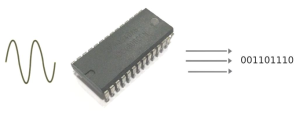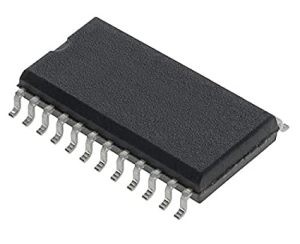
A/D Converter: Basic Principle and Types
August 22 2023 
Inquiry
Global electronic component supplier AMPHEO PTY LTD: Rich inventory for one-stop shopping. Inquire easily, and receive fast, customized solutions and quotes.
QUICK RFQ
ADD TO RFQ LIST
The A/D converter plays a crucial role in various applications, including telecommunications, audio processing, sensor data acquisition, and more. In this article, we will explore the basic principle behind A/D converters, the different types available, and their respective advantages and disadvantages.
Digital Signal and Analog Signal
Digital signals and analog signals are two distinct types of signals used in communication systems to transmit information. An analog signal is a continuous waveform that represents information as varying amplitudes or frequencies. It is a representation of the original information continuously and smoothly. Analog signals can take on an infinite range of values within a given range and are often used to represent real-world phenomena. Examples of analog signals include sound waves, voltage levels, and temperature gradients. Digital signals, on the other hand, are discrete and non-continuous. They represent information using a series of discrete values, typically represented as binary digits (bits) of 0s and 1s. Digital signals are obtained by sampling and quantizing an analog signal at regular intervals. Each sample is assigned a specific discrete value, and these values are used to reconstruct the original information at the receiving end. Digital signals are less susceptible to noise and distortion compared to analog signals, making them more robust for long-distance transmissions. They also allow for error detection and correction through various coding techniques. The transition from analog to digital signals has been driven by advancements in digital technology, offering improved signal quality, higher data capacity, and better noise immunity. Digital signals are widely used in modern communication systems, including telecommunications, computer networks, and digital audio/video transmission.What is ADC?
ADC stands for Analog-to-Digital Converter or A/D Converter. It is an electronic device or circuit that converts analog signals into digital representations. The purpose of an ADC is to enable the processing and manipulation of analog signals in the digital domain, which is more suitable for various digital systems, such as computers and microcontrollers. ADCs are essential in various applications where analog signals need to be processed, stored, or transmitted digitally. They are commonly used in audio and video recording devices, measurement instruments, sensors, wireless communication systems, and many other fields where analog data needs to be converted into digital form for further processing or analysis. The accuracy of an ADC is determined by its resolution, which refers to the number of bits used to represent the digital output. Higher-resolution ADCs can provide more precise and detailed digital representations of the analog signal.
Basic Principle of A/D Converters
The basic principle of an Analog-to-Digital Converter (ADC) involves two main steps: sampling and quantization. Sampling: The first step in the conversion process is sampling. The analog signal is sampled at regular intervals to capture its amplitude at specific points in time. This sampling process involves measuring the value of the analog signal at discrete time intervals. The rate at which the signal is sampled is known as the sampling rate or sampling frequency. The sampling rate must be high enough to accurately capture the variations in the analog signal. Quantization: Once the analog signal is sampled, the next step is quantization. Quantization involves assigning a digital value to each sample. The continuous range of amplitude values in the analog signal is divided into discrete levels. The number of levels is determined by the resolution of the ADC, which is usually specified in bits. For example, an 8-bit ADC can represent the analog signal using 2^8 = 256 discrete levels. The quantization process involves comparing the amplitude of each sample to the predefined levels and assigning the closest digital value. This digital value is typically represented by a binary number, where each bit represents a different power of 2. The more bits a converter has, the higher the resolution and the more accurately it can represent the analog signal. Once the analog signal is sampled and quantized, the ADC outputs a digital representation of the original analog signal. This digital representation can be further processed, stored, or transmitted digitally for various applications. The accuracy of an ADC is influenced by factors such as its resolution, linearity, and noise performance. Higher-resolution ADCs with better linearity and lower noise levels can provide more accurate and faithful digital representations of the original analog signal.Types of A/D Converters
There are several types of Analog-to-Digital Converters (ADCs), each with its characteristics and applications. The choice of A/D converter depends on the specific application requirements, such as accuracy, speed, power consumption, and cost. Successive Approximation ADC Successive Approximation ADC is one of the most common types of A/D converters. It uses a binary search algorithm to approximate the analog input signal. The converter starts with the most significant bit (MSB) and successively determines the digital value by comparing the input signal with a voltage reference. This process continues until the least significant bit (LSB) is determined. Successive Approximation ADC typically offers good resolution, moderate speed, and reasonable cost. Delta-Sigma ADC Delta-Sigma ADC, also known as oversampling ADC, is widely used in applications that require high resolution and accuracy. This type of converter employs a technique called oversampling, where the analog signal is sampled at a frequency significantly higher than the Nyquist rate. The oversampled signal is then filtered and converted into a digital representation using a delta-sigma modulator. Delta-Sigma ADCs provide excellent resolution, low distortion, and high accuracy but may have slower conversion rates. Flash ADC Flash ADC, also known as parallel ADC, is known for its high-speed conversion capability. It uses a bank of comparators to convert the analog input signal into a digital representation. Each comparator in the bank compares the input signal to a specific voltage level. The outputs of all comparators are then combined to obtain the digital representation. Flash ADCs offer very fast conversion speeds but are limited in terms of resolution and power consumption. Pipeline ADC Pipeline ADC is commonly used in high-speed applications that require both speed and resolution. It consists of multiple stages, each performing a partial conversion of the analog input signal. The conversion results from each stage are then passed to subsequent stages for further processing. The final output is the digital representation of the analog input signal. Pipeline ADCs provide high-speed conversion with good resolution but may be more complex and costly to implement. Sigma-Delta ADC Sigma-Delta ADC, also known as Delta-Sigma ADC, is widely used in applications that require high resolution and noise immunity. It utilizes a delta-sigma modulator to oversample and quantize the analog input signal. The quantized signal is then digitally filtered to obtain the final digital representation. Sigma-Delta ADCs offer excellent resolution, low distortion, and high noise rejection but may have slower conversion rates.
The Advantage of ADC
The advantages of using an ADC (Analog-to-Digital Converter) in electronic systems are numerous and significant. Here are some key advantages: Compatibility with digital systems: ADCs enable the interface between analog signals and digital systems. Many electronic systems, such as microcontrollers, computers, and digital signal processors, operate primarily in the digital domain. By converting analog signals into digital form, ADCs allow these systems to process, analyze, store, and transmit analog data efficiently. Improved accuracy and precision: ADCs provide a means to convert continuous analog signals into discrete digital values. This quantization process allows for the precise representation of analog data with high resolution. Higher-resolution ADCs can capture smaller changes in analog signals, resulting in improved accuracy and fidelity of the digital representation. Noise reduction: Digital systems are typically less susceptible to noise and interference compared to analog systems. By converting analog signals into digital form, ADCs help mitigate the impact of noise during signal processing and transmission. Digital signals can be processed using various noise reduction techniques, such as filtering and error correction algorithms, to improve the integrity of the data. Signal processing capabilities: Once in the digital domain, the converted data can be easily manipulated, processed, and analyzed using digital signal processing techniques. Digital systems offer a wide range of powerful algorithms and tools for filtering, modulation, demodulation, compression, encryption, and many other signal-processing operations. ADCs enable the utilization of these advanced processing capabilities on analog signals. Flexibility and reusability: ADCs provide flexibility in system design and reusability of components. By converting analog signals to digital, different processing algorithms and techniques can be applied to the same data, allowing for versatile system functionality. Additionally, digital data can be stored, transmitted, and shared easily, making it suitable for various applications and future system expansions. Integration with digital communication protocols: ADCs facilitate the integration of analog signals into digital communication systems. Digital data can be easily transmitted over standard digital communication protocols, such as USB, Ethernet, or CAN Bus, enabling seamless connectivity with other devices and networks. Calibration and compensation: ADCs often include features and techniques for calibration and compensation of non-idealities, such as offset and gain errors. These capabilities allow for more accurate measurements and better performance in practical applications. Overall, the advantages of ADCs include compatibility with digital systems, improved accuracy, and precision, noise reduction, signal processing capabilities, flexibility in design, integration with digital communication protocols, and calibration capabilities. These advantages make ADCs indispensable in a wide range of applications, including data acquisition, sensor interfacing, audio and video processing, communication systems, and industrial automation.Conclusion
In conclusion, Analog-to-Digital Converters (ADCs) play a vital role in modern electronic systems by converting continuous analog signals into discrete digital representations. The basic principle involves sampling the analog signal and quantizing it into digital values. Various types of ADCs cater to different application needs. Successive Approximation ADCs offer simplicity, while Delta-Sigma ADCs provide high resolution. Flash ADCs offer fast conversion, and Dual Slope ADCs prioritize accuracy. Pipeline ADCs are suitable for high-speed conversions. Despite limitations such as quantization error, limited dynamic range, and sensitivity to noise, ADCs bring compatibility with digital systems, improved accuracy, signal processing capabilities, and flexibility. Understanding the basic principle and types of ADCs helps in selecting the most appropriate solution for specific application requirements.Related Articles
- ·Stratix 10 VS Stratix V: Which FPGA is Right for Your Next Project?
- ·Intel Xeon Platinum 8454H vs AMD EPYC: Which Reigns Supreme?
- ·A Deep Dive into the AMD EPYC 4564P Processor
- ·MSP430F5438A vs MSP430F5529: A Detailed Analysis of Their Capabilities
- ·Comparing MSP430F6659 and MSP430F5419A: Which One is Right for Your Project?
- ·Exploring the Features of MSP430F5529 and MSP430F5638 Microcontrollers
- ·Demystifying 20 Microcontroller Projects for Beginners
- ·Unveiling the Ultimate Guide to Microcontroller Programming
- ·4680 Battery: Unveiling the Power Potential of the Next-Gen Cell
- ·Exploring the Case Studies on Arduino Applications
Populer Posts
STM32MP153AAD3
STMicroelectronics
MIMX8MN2DUCJZAA
NXP Semiconductors
P5040NXN72QC
NXP Semiconductors
R8A774C0HA01BG#U0
Renesas Electronics America Inc
MCIMX6D4AVT08ACR
NXP Semiconductors
MCIMX537CVV8CR2
NXP Semiconductors
KMPC8360EVVAJDGA
NXP Semiconductors
XLP104B1IFSB00080G
Broadcom
ATSAMA5D27C-CNRVAO
Microchip Technology
RK80546KG0801M
Intel
KMPC862TCZQ80B
NXP Semiconductors
LS1023AXN7KQB
NXP Semiconductors
